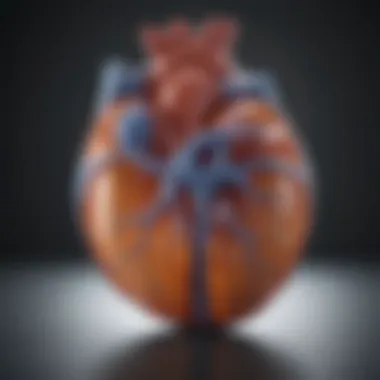Comprehensive Approaches to Treating Acute Kidney Injury


Intro
Acute kidney injury (AKI) represents a significant clinical challenge, impacting patient outcomes and healthcare resources globally. Understanding AKI is essential for both healthcare professionals and researchers. Awareness of its definition, underlying causes, and management strategies can lead to better patient care and improved survival rates. In this article, we aim to dissect the complexities of AKI, exploring its pathophysiology, diagnostic tools, and treatment options.
Through our exploration, we highlight the relevance of early intervention, which can prevent the condition from deteriorating to chronic kidney disease.
The following sections will guide readers through key concepts related to AKI, strategies for treatment, and insights into future research directions.
Understanding Acute Kidney Injury
Acute kidney injury (AKI) is a significant medical condition marked by a sudden decline in kidney function, affecting various aspects of a patient's health. Understanding AKI is paramount because early recognition and appropriate management can mitigate severe complications, including progression to chronic kidney disease. The insights into its pathophysiology, epidemiology, and cause elucidate the complex nature of this condition, making it essential for clinicians and healthcare providers to be well-versed in it. By grasping these elements, professionals can better navigate the intricacies of patient assessment and treatment.
Definition and Epidemiology
AKI is defined by a rapid loss of kidney function, typically over hours or days, indicated by an increase in serum creatinine or a reduction in urine output. Epidemiological studies suggest that AKI affects up to 20% of hospitalized patients, with certain populations, such as the elderly or those with underlying health conditions, at even greater risk. The condition has multiple risk factors and is associated with significant morbidity and mortality, thus highlighting the importance of timely diagnosis and intervention.
Pathophysiology of Acute Kidney Injury
The pathophysiology of AKI is multifaceted, often involving alterations in renal perfusion, injury to renal parenchymal cells, and occlusion of the renal tubules. Disturbances in hemodynamics can lead to prerenal causes, such as hypovolemia or decreased cardiac output, which compromise blood flow to the kidneys. Alternatively, intrinsic causes involve direct damage to renal cells due to toxins or ischemia. Understanding these mechanisms is necessary for implementing effective preventative and therapeutic strategies.
Common Causes of AKI
Common causes of AKI can be categorized into three main types: prerenal, intrarenal, and postrenal causes. Each category offers different insights into the potential triggers of kidney injury and requires tailored management strategies.
Prerenal Causes
Prerenal causes of AKI involve factors that reduce blood flow to the kidneys. Conditions such as dehydration, heart failure, or sepsis can significantly hinder kidney perfusion, leading to renal impairment. A key characteristic of prerenal causes is that they are often reversible with timely intervention, such as fluid resuscitation. This aspect makes understanding prerenal causes beneficial for clinicians, as addressing these factors promptly can restore kidney function and improve patient outcomes.
Intrarenal Causes
Intrarenal causes arise from direct damage to the renal tissue, often attributed to nephrotoxins, such as non-steroidal anti-inflammatory drugs (NSAIDs) or certain antibiotics, and acute glomerulonephritis. The distinguishing feature of intrarenal causes is the potential for significant and sometimes permanent kidney damage, making early identification crucial. This underscores the need for appropriate diagnostic measures and the careful use of medications that may exacerbate renal dysfunction.
Postrenal Causes
Postrenal causes of AKI stem from obstruction in the urinary tract, which impairs the outflow of urine from the kidneys. Examples include kidney stones, tumors, or an enlarged prostate. The key characteristic of postrenal causes is that they may be resolved through interventions such as catheterization or surgical procedures. Understanding these causes provides a broader perspective on AKI and informs treatment options that can effectively relieve obstruction and restore kidney function.
"Early detection and management of AKI can significantly improve patient outcomes and reduce the risk of chronic kidney disease."
Clinical Presentation and Diagnosis
The topic of Clinical Presentation and Diagnosis is crucial in understanding acute kidney injury (AKI). It allows healthcare professionals to identify the condition effectively and apply timely interventions. Early recognition of AKI can dramatically influence patient outcomes and minimizes the risk of progression to chronic kidney disease. Moreover, a thorough grasp of signs and symptoms helps in stratifying patients based on their risk, ensuring that those with more severe conditions receive appropriate and immediate care.
Signs and Symptoms
The signs and symptoms of acute kidney injury can vary considerably, depending on the underlying cause and the patient's overall health. Common signs to watch for include:
- Decreased urine output: This is often one of the first noticeable symptoms. A sudden drop in the amount of urine produced can be a strong indicator of kidney issues.
- Swelling: Fluid retention can occur due to impaired filtration. Patients may experience swelling in the legs, ankles, or even around the eyes.
- Fatigue: A feeling of extreme tiredness may arise as the kidneys struggle to maintain balance in the body.
- Nausea and vomiting: These symptoms may result from the buildup of toxins that affect the body's normal functions.
Prompt recognition of these symptoms is vital in managing AKI and can often lead to quicker diagnoses and more effective treatment strategies.
Diagnostic Testing
Diagnostic testing is essential for confirming AKI and determining its severity. This process often involves various tests, and each has unique contributions.


Blood Tests
Blood tests serve as a critical component in diagnosing AKI. They assess kidney function by measuring levels of substances such as creatinine and urea nitrogen. The primary characteristic of blood tests is that they provide immediate insights into the body's metabolic status. Elevated creatinine levels are commonly linked to reduced kidney function, making blood tests a popular choice in diagnosing AKI.
The unique feature of blood tests is efficiency. They can be done quickly, providing timely information that often influences treatment choices. However, potential disadvantages include the possibility of false positives or negatives, which can complicate the clinical picture.
Urine Tests
Urine tests are another valuable tool in assessing kidney function. They can identify abnormalities in urine production and chemical composition. A crucial aspect of urine tests is that they help differentiate between prerenal and intrarenal causes of AKI. This distinction can be critical in guiding management.
The key characteristic of urine tests is their ability to reveal specific insights about tubular function and damage. They also provide information about electrolyte balance. One potential drawback is that urine tests may take longer to interpret than blood tests, leading to delays in decision-making.
Imaging Studies
Imaging studies are integral when the cause of AKI needs further investigation. Techniques such as ultrasound, CT scans, or MRI can visualize the kidneys and urinary tract, highlighting obstructions or structural changes. Transporting the patient for imaging can be a limitation, but it often augments the diagnostic process significantly.
The significant characteristic of imaging studies is their capability to visualize anatomy and any potential obstructions. This can provide insights that physiological tests may not reveal. However, the disadvantages include exposure to radiation in some modalities and potential costs, which may restrict their accessibility in some situations.
The combination of clinical symptoms and diagnostic tests offers a comprehensive approach to understanding kidney function and the impact of various factors affecting it.
Initial Assessment and Monitoring
The initial assessment and continuous monitoring of patients with acute kidney injury (AKI) are critical for effective management and positive outcomes. Early identification of AKI allows for timely interventions that can mitigate further damage and improve the likelihood of recovery. Understanding the patient's baseline kidney function, identifying risk factors, and initiating appropriate treatment before significant decline occurs are essential steps that healthcare providers must prioritize.
Risk Stratification
Risk stratification involves categorizing patients based on their likelihood of developing AKI and the potential severity of the condition. This process is crucial for tailoring monitoring and treatment strategies effectively. Factors that may increase the risk of AKI include existing chronic kidney disease, diabetes, exposure to nephrotoxins, and major surgery. By assessing these risk factors, clinicians can implement targeted preventative measures, such as optimizing fluid status and carefully managing medication regimens.
To facilitate this process, several scoring systems have been developed, including the RIFLE and AKIN criteria. These frameworks provide a structured approach to determining the severity of AKI based on changes in serum creatinine and urine output. Understanding these risk stratification methods is vital for healthcare providers, allowing them to spot high-risk patients and initiate early interventions.
Continuous Monitoring Techniques
Continuous monitoring is essential in managing patients with AKI. Various techniques are employed to closely observe renal function and detect changes in real-time. Key methods include:
- Serum Biomarkers: Regular measurements of serum creatinine, blood urea nitrogen, and electrolytes help clinicians track kidney function and assess the effectiveness of interventions.
- Urine Output Monitoring: Accurate measurement of urine output provides direct insight into renal perfusion and function. Decreased urine output can be an early indicator of kidney injury, warranting timely action.
- Advanced Imaging Techniques: Non-invasive imaging techniques, such as ultrasound, can be used to evaluate renal size, structure, and blood flow.
- Continuous renal function monitoring devices: Technologies like implantable renal monitors provide crucial data for assessing kidney health over time, aiding in timely adjustments to treatment plans.
Continuous monitoring not only helps in observing the progression of AKI but also assists in modifying treatment strategies as required to prevent deterioration into chronic conditions.
By incorporating rigorous assessment and monitoring protocols, healthcare professionals can significantly improve patient outcomes in acute kidney injury. The initial and ongoing evaluation is essential to identify changes promptly and adjust treatment plans effectively, thus emphasizing the importance of this foundational aspect of AKI management.
Treatment Strategies for Acute Kidney Injury
The treatment strategies for acute kidney injury (AKI) represent a crucial segment in the management of this condition. Understanding these strategies allows healthcare professionals to implement effective approaches tailored to individual patient needs. The objective is to mitigate kidney damage, restore function, and prevent further complications. Various treatment modalities exist, ranging from conservative to interventional techniques, which must be carefully weighed based on the patient's unique clinical scenario.
Conservative Management
Conservative management forms the foundation of initial treatment in many cases of AKI. This encompasses a range of supportive measures aimed at optimizing kidney function without invasive procedures.
Fluid Management
Fluid management is a pivotal component of conservative management. It involves the careful administration of intravenous fluids to maintain hemodynamic stability and ensure adequate renal perfusion. This approach is critical during the initial phases of AKI, especially in prerenal causes where dehydration may be a contributing factor.
- The key characteristic of fluid management is its simplicity and effectiveness in promoting kidney health. It is a relatively straightforward intervention that can be adjusted based on patient response.
- One unique feature of fluid management is its adaptability. Healthcare providers can modulate fluid types and volumes according to ongoing assessments of fluid balance and renal output.
- However, there are disadvantages; excessive fluid administration can lead to fluid overload, complicating the clinical picture and potentially worsening kidney function.


Electrolyte Replenishment
Electrolyte replenishment is another critical element in conservative strategies. This practice addresses imbalances that often arise during AKI, such as low levels of potassium or magnesium.
- Its key characteristic is supporting homeostasis, which is vital in retaining normal physiological functions. Maintaining electrolyte levels can help prevent complications like arrhythmias and muscle weakness.
- A unique feature is the requirement for careful monitoring. Electrolytes must be replenished judiciously to avoid harming the patient. This method reduces the risk of further renal damage and promotes recovery.
- On the downside, over-replenishment can lead to hyperkalemia or other imbalances, demanding regular assessments to ensure safety.
Pharmacological Interventions
Pharmacological interventions play a significant role in treating AKI, especially in cases where conservative measures alone are inadequate.
Diuretics
Diuretics are frequently employed in managing AKI, particularly in fluid overload scenarios. They serve to increase urine output, facilitating the elimination of excess fluids and reducing the burden on the kidneys.
- The key characteristic of diuretics is their ability to provide immediate results, which can be crucial in acute settings. This makes them a popular choice for addressing signs of volume overload.
- A unique feature is the range of diuretics available, allowing tailored treatment plans. Loop diuretics like furosemide are commonly used to effectively manage fluid levels.
- However, overuse can lead to electrolyte disturbances, necessitating careful dosage adjustments and monitoring of renal function.
Renal Protective Agents
The use of renal protective agents has gained traction as a targeted approach to mitigate injury and preserve kidney function.
- A key characteristic of these agents is their ability to act at the cellular level, offering potential benefits in reducing apoptosis and enhancing repair mechanisms. This aspect drives their inclusion in treatment protocols.
- The unique feature lies in their application during the early stages of AKI, which can maximize their efficacy. Agents like angiotensin-converting enzyme inhibitors are examples that have shown promise in helping preserve renal structure and function.
- Conversely, caution is necessary. The response to renal protective agents may vary, and not all patients will achieve the desired outcomes, which necessitates individualized assessment.
Dialysis Considerations
In certain cases, dialysis becomes an essential therapeutic option when conservative and pharmacological strategies fail to stabilize kidney function.
Indications for Dialysis
Identifying the appropriate indications for dialysis is critical and can determine patient outcomes. Dialysis is indicated when metabolic derangements become life-threatening or when patients show persistent anuria.
- The key characteristic is its role as a life-saving intervention. Dialysis can rapidly correct fluid overload, electrolyte abnormalities, and azotemia.
- The unique feature of this approach is its dual capacity: it not only removes waste products but also can help restore electrolyte balance.
- Nonetheless, reliance on dialysis can signify more severe AKI and may indicate a poor prognosis, making timely decisions essential.
Types of Dialysis
Understanding the various types of dialysis available is important for tailoring treatments effectively.
- The key differentiators between hemodialysis and peritoneal dialysis center on patient needs and clinical conditions. Hemodialysis is often preferred due to its efficiency in toxin removal.
- A unique feature of peritoneal dialysis is its flexibility and potential for at-home treatment, which can enhance patient quality of life.
- However, the disadvantages vary; hemodialysis can entail risks such as access complications, while peritoneal dialysis may lead to infections and requires significant patient education.
Post-Acute Kidney Injury Care
Post-acute kidney injury care is crucial for ensuring optimized recovery and reducing the risks of complications. This phase focuses on managing and monitoring patients who have experienced an episode of acute kidney injury (AKI). The overall goal is to prevent the transition to chronic kidney disease and facilitate the recovery of kidney function.
Transition to Chronic Kidney Disease
The transition from acute kidney injury to chronic kidney disease often poses significant challenges. A key consideration is the persistence of renal impairment after the acute phase. Early recognition and intervention are vital. Healthcare providers should monitor renal function closely to identify any decline promptly. In many cases, patients may not return to baseline kidney function. As a result, screening for chronic kidney disease markers becomes essential.
One important element is the management of risk factors contributing to kidney deterioration. For instance, hypertension and diabetes must be controlled effectively. These comorbidities can exacerbate renal dysfunction, thereby compounding the issue. The integration of lifestyle changes and medication adjustments may improve outcomes in this context. Furthermore, patient education plays a pivotal role in encouraging adherence to prescribed treatments and regular follow-ups.
Follow-up Care and Monitoring
Regular follow-up care and monitoring are foundational to post-acute kidney injury management. Healthcare teams must ensure that patients receive the appropriate evaluations and interventions during this critical recovery period.
Nutritional Considerations


Nutritional considerations straight away impact overall kidney health. A balanced diet that is low in sodium and phosphorous is often recommended. Such diets can help mitigate kidney strain and assist in the body's recovery. Furthermore, protein intake should be carefully monitored. In some instances, restricting protein can ease the workload on damaged kidneys, while in other cases, sufficient protein is necessary for healing.
The key characteristic of nutritional considerations lies in their role in promoting renal health while satisfying individual dietary requirements. Effective nutritional strategies often lead to fewer complications and better renal outcomes. Keep in mind that customized dietary plans can enhance compliance and sustain recovery efforts. However, it's essential to note that unrealistic dietary changes can lead to frustration for patients.
Long-term Follow-up Protocols
Long-term follow-up protocols significantly contribute to sustained kidney health. These protocols ensure ongoing assessments of kidney function and management of potential complications. Regular testing can help track the progression or stabilization of kidney health, identify cardiovascular risks, and adjust treatment as needed.
Overall, the emphasis here is on structured follow-up care that fosters patient engagement. Patients are often more inclined to adhere to treatment plans if they understand the importance of regular monitoring. Unique features of these protocols include personalized care plans developed from baseline data and tailored health education sessions. However, effective long-term follow-up demands resources and commitment from healthcare teams, which can sometimes be a challenge.
"Post-acute care is fundamental for preventing the long-term complications associated with kidney disorders and ensuring optimal health outcomes."
Emerging Research and Future Directions
Emerging research on acute kidney injury (AKI) holds significant promise for improving detection and therapeutic strategies. As the understanding of this complex condition evolves, the focus shifts towards innovative methodologies that aim to optimize patient outcomes. This section delves into two critical areas: novel biomarkers for early detection and innovative therapeutic approaches, both of which could radically change the landscape of AKI management.
Novel Biomarkers for Early Detection
The discovery of novel biomarkers is vital in the context of AKI. Traditional methods for assessing kidney function, such as serum creatinine levels, often lag behind the actual renal injury. New biomarkers can offer insights much earlier, allowing for timely intervention which is critical for improving prognosis.
Some biomarkers currently under investigation include
- Neutrophil Gelatinase-Associated Lipocalin (NGAL): Elevated levels in urine can signal early kidney damage.
- Cystatin C: A protein that may serve as a more sensitive indicator of renal function than creatinine.
- Kidney Injury Molecule-1 (KIM-1): This is expressed in renal tubular cells following injury and can be detected in urine.
By incorporating these biomarkers into clinical practice, healthcare professionals may better stratify patient risk and tailor interventions. Research indicates that earlier identification of AKI can decrease the need for dialysis and reduce hospital stays, ultimately resulting in lower healthcare costs.
Innovative Therapeutic Approaches
In addition to early detection, innovative therapeutic approaches are being explored. These potential treatments may rescue kidney function or mitigate further damage after an acute injury. Some areas of research include:
- Renal Replacement Therapies: Advances in dialysis technology may provide finer control and improved outcomes for patients.
- Cardiorenal Interventions: Interventions that consider heart and kidney interactions, recognizing their interdependence.
- Use of Stem Cells: Preclinical studies suggest that stem cells might promote renal repair and regeneration, a promising avenue for future treatment.
Moreover, pharmacological therapies such as the deployment of anti-inflammatory agents or agents aimed at modifying the renal microenvironment show potential but require further investigation.
"The future of AKI management lies in the synergy of early detection and targeted therapies, potentially reducing complications and improving quality of life for patients."
The progress in these areas highlights the evolving capabilities within nephrology. As robust evidence emerges, clinicians can expect to apply these novel strategies to enhance care and reduce the incidence of chronic kidney disease following AKI.
Finale
The conclusion of this article serves as a critical reflection on the management of acute kidney injury (AKI). As we have explored, AKI is a complex condition that requires a nuanced understanding of its causes, presentations, and treatments. An effective conclusion not only summarizes the significant points discussed but also stresses the importance of proactive measures in managing this condition.
Drawing from the discussions throughout the article, we identified key elements that underscore effective AKI management. These include recognizing the early signs and symptoms, employing appropriate diagnostic tools, and implementing promptly managed treatment strategies. Moreover, careful monitoring and follow-up can significantly influence outcomes for patients affected by AKI.
"Early intervention and tailored management strategies are pivotal in preventing the progression from acute to chronic kidney disease."
The article emphasizes the need for a holistic view when treating AKI. Understanding the interrelated factors that contribute to kidney injury will allow healthcare professionals to devise comprehensive treatment pathways. Thus, we must not overlook any aspect of patient care— it can speak volumes about recovery outcomes.
Summary of Key Points
- Understanding AKI: It remains essential to recognize AKI's various stages and underlying mechanisms.
- Early Intervention: Timely diagnosis and management can significantly alter disease progression.
- Continuous Monitoring: Real-time patient observation allows for timely adjustments in treatment.
- Holistic Approach: Integrating patient history, current medication, and lifestyle factors leads to more effective management.
Importance of Holistic Management
Holistic management in AKI care encompasses a broad perspective on patient health rather than focusing solely on the kidneys. It involves taking into account the overall well-being of individuals, including underlying comorbidities, medication interactions, and psychosocial factors. This approach encourages interdisciplinary collaboration among healthcare providers to formulate a well-rounded treatment plan.
Key benefits of holistic management include:
- Reducing Hospital Readmissions: A comprehensive understanding of patient needs lowers the likelihood of relapse.
- Enhanced Patient Education: Informing patients about lifestyle modifications affects long-term outcomes positively.
- Tailored Treatment Plans: Personalizing care according to individual needs improves therapeutic effectiveness.



